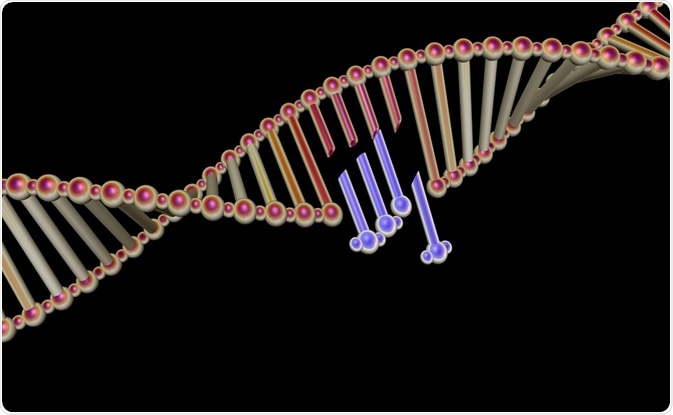Deletion mapping allows geneticists to answer several questions about a specific gene. It can determine where a deleted region of a gene is located, whether this deletion affects only the area in which the gene deletion occurs, and whether this can be rectified by way of recombination.
Skip to:
 vrx | Shutterstock
vrx | Shutterstock
What is Deletion Mapping?
Deletion mapping is a specialized genetic mapping technique that enables scientsts to determine the location of a specific gene on a chromosome. This technique is useful when the location of alleles, variants of a recessive gene, are known to be located within a specific region, but their specific location is unknown. Deletion refers to the production of two breaks in the arm of a chromosome, which liberates the interspersed portion of the genetic material, or gene.
In deletion mapping, deletions are performed in a homozygote, in which a specified portion of both copies of the gene being interrogated is deleted. The mapping process is able to determine whether the function of the deleted gene can be restored by crossing these deletion-mutants with a strain that possesses a point mutation in the gene of interest.
The Premise of Deletion Mapping
The logic that underpins the process of deletion mapping is that a donor strain, which carries a point mutation in the gene of interest, cannot restore the wild-type function of the gene when crossed with a recipient deletion mutant strain when both the point mutation and a region of the deletion coincide i.e. affect the same base pair. If the point mutation of one strain does not coincide with the deletion mutation in the other strain, then the restoration of wild-type function can occur.
There will be a recombination event, which allows the deletion to be repaired allowing the function of the gene to be restored. Recombination is the process by which new combinations of genes arise as the chromosome is broken and re-joined.
In the context of deletion mapping, the donor wild-type sequence in the region that corresponds to the recipients deleted region can invade and repair the deleted region, enabling restoration of gene function. This restoration indicates that the point mutation lies outside of the region deleted.
Deletion Mapping Methodology
The work of Seymour Benzer exploited the properties of deletions within a specific gene to map the positions of point mutations in the same gene in a rapid manner.
Benzer worked with the r gene located in the T4 bacteriophage. rII, in bacteriophage genetics denotes ‘rapid lysis’. There are several deletion variants of this gene that can induce the ‘rapid lysis’ phenotype. To experimentally locate the positions and determine the phenotypic consequences of these genetic mutations, bacteriophages are used as a model.
Bacteriophages are amenable to genetic mapping due to their rapid infection rates and high progeny number, which enables the detection of infrequent genetic events, such as recombination. Benzer sought to determine whether the wild-type phenotype could be reinstated through recombination events between deletion mutants.
A Simplified Explanation of Deletion Mapping
In his experiments, Benzer crossed pairs of deletion and point mutants and infected them on a bacteriophage lawn. To illustrate this, T4 variant 1 with a point mutation in gene r (rpoint1) crossed with a T4 variant 2 with a deletion mutation (r-del1) whose deletion region corresponds to the region containing the point mutation in the T4 variant 1, fails to restore the function of the r gene.
Genetic recombination will not restore wild-type r gene function. This demonstrates that if different types of mutation, such as point and deletion mutations, are located on the same gene, then the restoration of that gene's function is not possible as neither can compensate for the other.
Contrastingly, if the r-del1 mutant is crossed with a T4 variant 3 with a deletion mutation (r-del2), whose deletion region does not correspond to the region containing the point mutation in the T4 variant 1, a successful recombination event can occur as a restored gene sequence, devoid of either a point mutation or deletion is produced.
This indicates that these mutations do not coexist in the same region. Successful recombination can be visualized by plaque formation, as a result of bacteriophage lysis, or destruction because of the ‘rapid lysis’ gene function.
This simple model of deletion mapping can be extended to identify new mutation sites. The work of Benzer has allowed the subsequent mapping of several genes across several organisms.
When the point mutations are ascribed to a deletion region they can be ordered as using information gathered from other crosses. Hence, crosses between an uncharacterized mutation and a known deletion can be used to identify the location of point mutation.
Deletion mapping
Further Reading